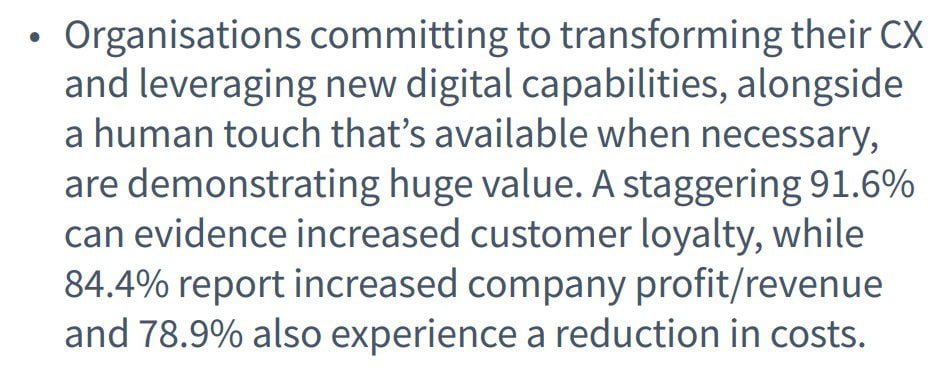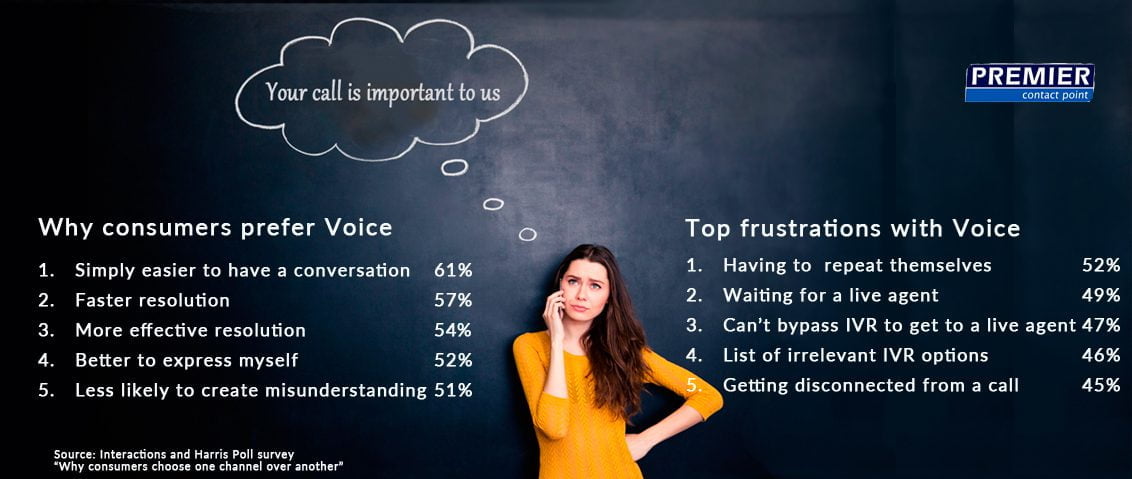As we know, consumers have become more demanding and more discerning about how they want to engage with you.
Some prefer speech, some prefer text, and some prefer still other modes – and preferences can differ across generations.
Technology enables organisations to offer live, assisted, and automated services across every mode, every channel, and every device imaginable – voice, text, phone, web, email, messaging, social, video, apps, kiosks, bots, voice assistants, IOT, and more.
When you make it easy for a customer to place an order, change their address details, get a balance, download a form, find an answer, book an appointment etc; you’re demonstrating how much you value your customers. You’re saying to them “We know your time is valuable, and that you might not have the time spare to potentially wait in a queue, so we’ve made it quick and easy for you to do it yourself.” This improves the customer experience you deliver, providing of course that the process really is easy and quick.
How customers feel impacts loyalty
But being quick and easy is not the be all and end all.
What is important is how customers feel about the CX you provide. In every industry sector, this has a bigger influence on loyalty than effectiveness or ease.
At the end of the day most humans, even the younger generations, still want and will always want an emotional connection to a brand.
And according to a recent report from Dimension Data, organisations agree. In their study they found:
 The danger of too much automation
The danger of too much automation
There’s no doubt that technology automation such as chatbots, AI and robotic processes are extremely useful for streamlining customer service and improving efficiency for customers and team members. Automation can enhance the Customer Experience in many ways.
But be careful – you may end up solving your problems with more and sometimes worse problems. Automation and self-service can be overdone, and actually have the opposite effect on the customer experience.
At a major conference last year, a representative from one of Australia’s leading organisations stood in front of his peers and acknowledged they had gone too far in trying to push their customers to self-serve through digital channels.
They had tried to improve CX by increasing speed and efficiency, but instead went too far and “over-digitised” their customer interactions. While some of the simpler self-service actions were easier for customers to carry out, when it came to them needing to escalate to a live agent for any reason (a point at which they might already be frustrated having come through the self-service process), it had been made very difficult for them to find assisted and live help when they really needed it. This meant increased customer frustration, reduced satisfaction and increased customer churn. In the end they recognised the need to get the balance right between digital, self-service, and live channels, and reoriented their investment and processes accordingly.
Do customers want live help or automation?
An interesting study on why customers prefer one channel over another, conducted by US AI vendor Interactions and market researchers Harris Poll, found that consumers are split roughly 50/50 between Voice and Text.
Their research found that those who prefer Voice do so when speed and efficiency is an issue. Voice is also preferred for more difficult enquiries – where there is more than one issue to address, extra support is required or where convenience or security is an issue.
More relevantly, they found that choice of channel MAY be driven simply by frustration with other channels.
 Figure 1 – Consumer Thoughts on the Voice Channel
Figure 1 – Consumer Thoughts on the Voice Channel
Figure 1 shows the key reasons why consumers prefer Voice, which is for speed and efficiency. It also identifies the top five consumer frustrations with Voice, and these need to be addressed.
They found that many organisations use old or poorly designed technologies to deflect to self-service or limit the conversation.
Take automated systems like IVRs and speech recognition for example.
IVRs are often poorly designed, with too many levels and options and superfluous information. It’s frustrating and time-consuming for a customer to listen to (and remember) 5 options, choose one, listen to another 5, choose one and then listen to another 5 before finally hearing the option to speak to a live agent or request a call back.
When combined with speech recognition, IVRs can become quite stressful. Some speech recognition technology is not accurate enough, and forces customers to repeat themselves, wait on hold, and speak like a robot to get their issues resolved.
The important message here is that while digital channels must and will grow and eventually deliver enormous benefits, we have to get Voice right because it’s still critical for customer service.
Get the balance right between Digital and Voice
It’s important to have the right balance between Digital and Voice as part of your CX strategy. You need automation to provide self-service choice and improve efficiency, particularly for managing volumes; but not at the expense of human connection.
The level of automation that you deploy will depend on the type of industry, your customer needs, the complexity of your product/service offerings and the volume of inbound contacts.
For example, people don’t need to contact a human being to reset a password, but they do need one when they have a question about a service or a procedure, or multiple questions.
US company SpareFoot connects consumers with self-storage facilities, and according to VP Technology Josh Lipton, they have implemented the ideal balance. If an agent is not already on a call, customer calls are routed directly to a person, skipping the IVR system entirely. Even if the call is routed to the IVR, SpareFoot uses technology that provides the agent with detailed information about the customer, including which storage facilities the customer viewed on the company’s website. This speeds up the call and removes the need for customers to repeat information they’ve already provided.
“We just want to create the best possible experience,” Lipton said. “Our brand is our customer experience and our customer experience is our brand. You can’t separate the two.”
CX with connection and emotion is desired
Just about every organisation on the planet knows that CX is the most important differentiator of all today. Those that break away from the pack and consciously develop the human connection, rather than limit it, will be rewarded with emotional connection and loyalty.
How customers feel about CX has a bigger influence on loyalty to a brand than mere convenience or ease across every industry. At the end of the day most humans, even the younger generations, still want and will always want an emotional connection to a brand.
Exceptionally Efficient Voice Channel Management
Premier Contact Point is the cloud contact centre solution used by organisations who deliver outstanding customer experience. Our solution helps Customer Contact teams to engage with customers with ease and efficiency via all channels, particularly the most important one of all – Voice.
